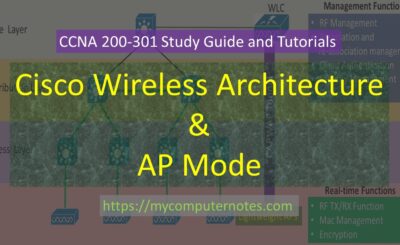In this series of CCNA 200-301 tutorials, we will discuss the different types of physical interfaces and cabling types used in the local area networks. This section will focus on different types of Ethernet cables, copper type cables like UTP and STP, Fibre optic cables (single-mode and multimode), Ethernet cable standards and their connectors.
Physical Interfaces and Cabling types in networking
The physical interface is the physical port or the network adaptor provided in network devices that are used to connect different types of cables for data communication.
The different types of physical interfaces used in Cisco routers and switches are:
- Ethernet: Ethernet is defined as IEEE 802.3 standards. It has a speed of 10 Mbps. The media used for Ethernet is 10baseT.
- Fast Ethernet: Defined as IEEE802.3u standard and it has a speed of 100 Mbps. the media used for fast ethernet is 100 base T
- Gigabit Ethernet: The gigabit ethernet is defined as IEEE 802.3ab standard. It has a speed of Gbps. The media used for gigabit ethernet is 1000 base T
- Serial Interface: The serial interface is typically a WAN interface generally facilitated by service providers. Most of the time, one end is taken as DCE (Data Communication Equipment) and the other end as DTE(Data Terminal Equipment). In order to have serial communication, both stations must be synchronised with an appropriate clock speed. The DCE end will decide what would be the clock speed or the bandwidth of the channel.
- FDDI: The acronym for FDDI is Fibre Distributed Data Interface. FDDI uses an optical fibre network to data transmission at the rate of 100 Mbps up to 200 meters. FDDI network implements token passing technique to avoid collisions.
Naming Convention of Physical Interfaces of Routers and Switches
The physical interfaces of network devices like routers and switches are denoted by their interface IDs. The interface Id represents the media types, slot numbers and location parameters.
The interface IDs of routers and switches are represented as:
<InterfaceType><SlotNumber><PortNo>
For example :
FastEthernet0/1 or fa0/1 denotes the FastEthernet interface with slot no 0 and port no 1
Serial0/0 or s0/0 denotes the serial interface with slot no 0 and port number 0.
Compare physical interfaces and cabling types
Physical Interfaces and cables play a major role in connecting the different devices and the network components throughout the network. The Ethernet physical cable can be :
- Copper cable
- Optical fibre cable
Copper cable or Twisted Pair Cable

In Ethernet technology, the most common type of copper cable used is twisted pair cable. The twisted-pair cable is made up of two copper wires twisted together. Each copper wire has a coating of insulation. One of the conducting wires carries a signal and the other one acts as a ground. Two wires are twisted together in order to reduce noise or cross talk. The more the number of twists or twists, the greater will be the transmission speed.
Types of Twisted Pair cable
There are two types of twisted pair cable.
- UTP (Unshielded Twisted Pair) Cable
- STP(Shielded Twisted Pair) Cable

Unshielded Twisted Cable (UTP)
UTP cable is composed of two or four pairs of copper wires twisted together in pairs without any shielding. Two pairs of wires are twisted together to cancel the external noise and reduce the capacitance between the two copper wires. UTP cable is most commonly used for telephone and Ethernet connections. It is cheaper and easy to install.
Shielded Twisted Pair (STP)
STP cable is composed of four pairs of copper wires. Each pair is shielded with an aluminium file and all the shielded pair is bunched together within the diagonal wire mesh. The shielding provides better noise reduction and protects from electromagnetic interference. the shielding also provides a better data transfer rate than the UTP.
However, the cost of installation of cable is higher than that of UTP. STP are useful eclectic power lines or cables that run parallel with the networking cable.
Different categories of twisted pair cable

- Cat 1: CAt 1 is a single pair twisted cable that is used only for voice communication old telephone networks.
- Cat 2: Cat 2 cable consists of 4 pairs of wire, It is used for token ring network and have a data transmission of up to 4 Mbps.
- Cate 3: Cat 3 consists of 4 pairs of wires. It is used in both token ring and Ethernet networks with data transmission up to 10 Mbps.
- Cat 4: It also consists of 4 twisted pairs and it can have a data rate of up to 16 Mbps. It was used in IBM token ring network.
- Cat 5: Category 5 cable can transmit up to 100 Mbps. It has more number of turns of twisted pairs that helps to achieve a higher data rate and more resistance to cross talk. An example of Cat 5 is 100 Base-T.
- Cat 5e: Cat5e stands for category 5 enhanced. It is a subtype of cat 5 and supports data rate up to 1 Gbps od 1000Mbps.
- Cat 6: It looks identical to cat 5. A physical separator is placed between each pair in order to reduce electromagnetic interference (EMI). It is designed to support the data transmission rate up to 1Gbps.
- Cat 6e: Cat 6a stands for category 6 Augmented. It is designed to support data rates up to 10 Gbps spanning a distance of 100 meters. Cat 6a cables have more numbers of twists and each pair is shielded to reduce cross-talk efficiently.
- Cat 7: It consists of 4 pairs of tightly twisted copper wires. Each pair is shielded with foil and overall pairs are covered with a wired braid conductor. It can support data rates of up to 40Gbps at a distance of 100 meters.
- Cat 8: Cat 8 can support a bandwidth of 2 GHz. It is designed to support a data rate of 25 GHz to 40Ghz at a distance of 30 meters. It is specially used in data centres to connect routers and switches for very high-speed data transfer over a short distance.
RJ-45 Connector

RJ-45 connectors are used to connect different types of twisted pair cable(UTP/STP) at each end.
RJ-45 (Registered Jack-45) connector is an 8 pin modular plug that is attached to the Ethernet cable at the end of the cable. RJ-45 connector at both ends of the Ethernet twisted pair cable is popularly called Ethernet patch cord or cable.
Types of RJ 45 Ethernet cables

- Straight-through cable
- Cross-over cable
- Roll-over cable

Straight through Cable
The straight-through cables are the most widely used Ethernet LAN to connect a computer or server to a network switch or router. The cable consists of four pairs of twisted wires. Each pair has different colour codes with RJ 45 connectors at each end with the same pinout at both ends.
The RJ45 cable comes in two standards as defined by TIA (Telecommunications Industry Association) for maintaining consistency throughout the Ethernet network. It can be either T568-A or T568B standards.


Use of straight cable
- Switch to Router
- Switch to PC /Workstation/ Servers
- Hub to PC or Server

Cross Over Cable
Unlike Straight through cable, Cross over cable pinout is different as compared to the straight-through cable. It uses both the TIA standards at each end of the cable. You can find T568A type at one end and T568B type at the other end. The wires for transmitting and receiving signals are reversed at the respective end.

Use of cross cable
- Switch to Switch
- Hub to Hub
- Router to Router
- PC to PC
- router to PC

Roll Over Cable
The roll-over cable, also known as Cisco Console Cable is used to connect the router’s console port with the computer terminals. It also consists of four pairs of flat cables and the pinout at one end of the cable is revered at the other end.
the rollover cable is used to connect the computer with the console port of the switch or the router for configuring the device. most of the time rollover cable is attached with RJ-45 to the DB9 connector to connect the cable with the com port of the computer. However, an integrated cable with RJ 45 at one end and the DB 9 connector at the other end is also available to connect the device without using RJ45 to the DB9 connector.

| ←Prev | Next→ | |
| Cisco Network Topology Architecture |
Optical Fiber Cable & its Types |





